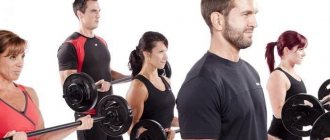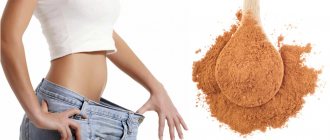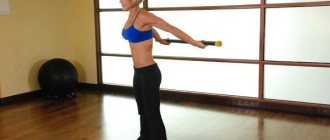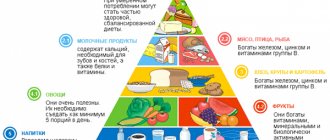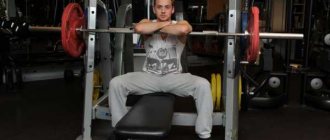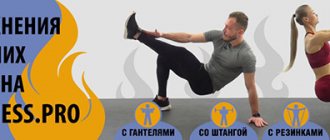What muscles work when riding a bicycle?
Cycling for weight loss helps achieve results in several areas at once:
- Stomach. While cycling, the abdominal muscles work. If you have previously “dried out”, then it becomes possible to create relief squares of the press. Otherwise, regular exercise will allow you to remove extra centimeters from your belly;
- Buttocks. Cycling for weight loss helps strengthen the gluteal muscles, making the buttocks firm and smooth;
- Inner thigh in the groin area. This area is difficult to reach for many weight loss practices. Fortunately, cycling can strengthen the iliacus muscle located in this area;
- Anterior thigh. This area contains the biceps and quadriceps femoris muscles. By pumping them up, the hips become slender and sculpted;
- Caviar. The calf muscles are involved in pedaling, so this area will also look sculpted and slender.
Unfortunately, during cycling training for weight loss, the upper body is poorly trained (with the exception of episodes of high-speed riding and hill climbs).
Warm-up
Before a cycling race, warm up and prepare your ligaments and joints for intense training. A 2-10 minute warm-up, after a state of rest, will help to smoothly speed up the work of the heart and ensure the outflow of blood from the internal organs to the muscles of the body.
- We stretch our shoulders. Feet shoulder-width apart, arms relaxed. As you exhale, you raise your shoulders; as you exhale, you lower them.
- Raise your arms above your head, bend them at the elbows, stretch left/right.
- Swing your arms in a circular motion.
- Walk with your knees high
- Jump from one to the other.
- Lunge forward with your feet, first with your right 4 times, then with your left.
- Stand up straight, then bend over and reach the floor with your hands as you exhale.
- Circular movements with feet and hands.
- Turn the body left/right 9 times, placing your hands behind your back.
After training, also warm up, since while driving a bicycle some parts of the body experienced a lack of motor activity: bend forward, to the sides. Simple stretching exercises will relax the muscles in your back, legs and shoulders. You can perform the exercises while holding the handlebars or saddle.
Advantages and disadvantages of cycling
A cyclist will answer positively the question “Is it possible to lose weight while riding a bicycle?” This unambiguity is associated with the multiple advantages of this sport:
- Being a cardio exercise machine, a bicycle develops the cardiovascular system and allows you to achieve heart rate levels during training at which fat burning occurs (more than 110-120 beats per minute). In addition, the lungs become adapted to heavy loads - endurance increases. This is a useful quality for those who want to lose weight through sports;
- Cycling, even at a walking pace, can “burn” 270-300 kcal per hour, and with intense training, from 500 to 750 kcal per hour. For comparison, in an hour of running a novice athlete will lose 300-400 kcal at best;
- Fat burning begins 40 minutes after the start of the workout;
- With regular cycling training, results are visible within the first 2-3 weeks, and weight loss in the first month is about 3-6 kilograms (depending on your initial weight, eating style and a number of other factors).
Among the household advantages, we note:
- Bicycles are environmentally friendly because they do not produce exhaust gases;
- With good care, your bicycle will serve you for many years and even decades;
- It is easy to maintain and store the bike - it takes up little space, and if necessary, it can be disassembled into spare parts.
There are, of course, disadvantages to the bicycle. They are as follows:
- Riding in the wrong position can harm the knee joints, and the weight loss process will be uneven;
- Seasonality of sports exercises. If we exclude from the statistics professionals and advanced amateurs who ride bicycles all year round (except for completely unsuitable circumstances - rain, hail, snowfall, ice), beginners can only ride in more or less warm and dry weather. In our latitudes this is approximately from March-April to October-November;
- Need for maintenance. In order for a bicycle to serve for a long time, you need to regularly carry out technical inspections, lubricate parts, and timely replace worn ones. This will require some investment of time and money;
- A bicycle is quite a dangerous projectile.
Despite these shortcomings, many have already found the answer to the question “Does cycling help you lose weight?” - "Yes!".
Useful tips for beginners
Think of the time spent behind the wheel not as burning calories, not as violence against your body, but as a fun pastime. You will be adequately rewarded for your ease and openness to fitness training. We give useful recommendations to beginners:
- Use a backpack. Place a change of clothes in it to absorb sweat. After a fitness workout, you can change into dry clothes before returning home.
- If cycling workouts will exceed 40 minutes (that’s how long it takes to start the fat-burning process), dress comfortably. Shoes should have a hard sole so that your foot can rest confidently on the pedal.
- After a trip that burns fat deposits, no matter how much you want to eat, wait 1-2 hours. To lose weight, aerobic exercise is combined with increased portions of food.
- When losing weight, your prerogative is to eat low-calorie foods: vegetables, fruits, fiber, low-fat fish and meat.
- In addition to your equipment, wear sneakers with non-slip soles.
- Dark glasses will be your salvation from dust and sunlight.
Don't forget to bring your pump and tools for emergency repairs.
https://youtu.be/8-hgseg3Xy4
Contraindications for cycling
Despite the versatility of this device, there is a category of people for whom it is contraindicated. Patients who are sick should avoid cycling:
- With a history of leg joint diseases;
- With disorders of the vestibular apparatus;
- With diseases of the cardiovascular system, respiratory organs;
- With varicose veins of the lower extremities and thrombophlebitis.
Experts express conflicting opinions about cycling during pregnancy. If you rode a bike before pregnancy, you can continue training after consulting with your doctor. For this purpose, areas of a flat road that are safe from cars are suitable. Driving over potholes and potholes can result in a miscarriage.
For safety reasons, it may be appropriate to move cycling training to the gym. When training, you must remember to drink enough water and rest if you are tired. You cannot drive downhill or press the pedals with force.
If you weren’t involved in cycling before pregnancy, then you definitely can’t start. During this period of your life, a diet for pregnant women is optimal for you.
Exercises
A bicycle is a universal exercise machine that helps to significantly improve your health, develop muscles, speed up metabolism, and removes excess fluid from the body (in the form of sweat, when exhaling).
To withstand long cycling, you need to develop the muscles of the body - the foundation of the musculature (muscles of the back, abdomen and thighs). Strong muscles will hold the body well. Save more energy for leg work when you ride long distances.
Do your workouts at home:
- Exercises “plank”, side plank for 30 seconds. several approaches.
- Superman pose. Lie on your stomach, raise your right hand from the floor for 20 seconds, do the same with your left hand. Lower your arm and lift your legs one at a time. Then raise both your arms and legs. Hold this position for 30 seconds.
- Ab exercise: lying on your back, bend your knees, turn your body left/right.
- From a supine position. Bring your chest towards your bent knees. Hands behind your head. Keep your shoulders straight. Stay in this position for 20-30 seconds. Do this several times.
How to choose a bike for weight loss
To know how to ride a bicycle correctly to lose weight, you need to understand the types of bicycles - the riding style needed to lose weight will depend on your choice.
The first thing you should decide before purchasing is your budget.
Then you need to determine the frame size that is right for you. There are special tables for this.
There are many types of bicycles, the most relevant for weight loss are the following:
- Mountain bike. This variety is the most common. It is suitable for both city and off-road driving. The shells are characterized by a comfortable fit, which allows you to ride for a long time, and a sufficient level of comfort. This is the best option both for losing weight and for everyday trips, short and long distance rides. Modern modifications of mountain bikes may have guards, places for attaching a basket and a bag, which brings them closer to city bikes.
- City bike. It has a high seating position, which is highly comfortable, and a wide, soft saddle that is comfortable to sit on. All mechanisms of these bicycles are often covered with shields, which increases service life. Despite this, an upright position is the least physiological when riding a bicycle, since the shock-absorbing load is completely transferred to the back. This variety is suitable for those who like to take an unobtrusive ride or go on a short trip a couple of times a week. City bicycles are not recommended for regular training to lose weight, although they are not prohibited if you choose leisurely, leisurely rides.
- Road bike. This variety is designed for fast riding in races and bike rides. This is a good option for losing weight, but it requires preliminary physical preparation. It will be hard to ride a road bike from scratch. For beginners, it is better to choose a road bike with the ability to switch gears so that you can adjust the severity of the pedals. More experienced riders can choose a fixed-gear system, which has only one gear.
- Hybrid. This is a mixture of mountain and road bikes. From the mountains, the hybrid took a strong frame, heavy wheels with a pronounced tread on the tires, a suspension fork, a straight steering wheel, an abundance of attachments, and frame geometry. From road bikes, the hybrid received narrow tires and large physical dimensions of the stars. Also a good option for weight loss and everyday driving.
https://youtu.be/r2OgBVk2Iyw
The best way to choose a comfortable bike is in a showroom, where you can try out all the models and ride the one you like.
Adviсe
If you went to a deserted place and your tire got punctured and you don’t have a spare tire. What to do? Inspect the damaged camera, find the flaw. Here, cut the camera in half with a knife. Tie the ends of the resulting “hose” into a knot to create a vicious circle. Insert it in place of the camera. Pump up a little and go home.
A more radical situation: you are in a field, you have a punctured tire, and you don’t have a spare tire or a pump with you. What to do? Disassemble the tire and remove the tube. Cut it lengthwise into pieces (10-12 strips). This can be done in front.
You will need: grass, cones, twigs and any vegetation that can be used to “stuff” the tire. Tie strips around the tire and rim. You won't be able to roll quickly, but you will be able to get home twice as fast as walking.
What accessories are needed for cycling?
To make your workouts not only effective, but also safe and comfortable, you will need:
- Protection. This includes a helmet and gloves. If desired, you can also buy knee pads and elbow pads. The importance of these accessories should not be underestimated. In case of a fall, they can save your health or even life;
- Flashlight, reflectors;
- Cycling computer. It counts driving speed, number of kilometers traveled and other important indicators;
- Heart rate monitor. This is optional, but advisable for those who want to track their heart rate during exercise;
- Bicycle locks;
- Water flask;
- Elastic, comfortable clothing, cycling clothing if desired.
This is the minimum set of devices and devices that may be useful. Over time, you will be able to independently determine what else would be worth purchasing.
Preparing equipment
Comfort and safety are the basic rules for preparing equipment.
- Equipment. It will ensure your safety or prevent the nuisance of falls and accidents. Bicycles develop quite a bit of speed, so don’t neglect your helmet, knee pads, and elbow pads. Cycling gloves and shorts with padding will relieve chafing.
- Choose a two-wheeled vehicle with a chrome alloy frame; aluminum is fragile, steel is heavy.
- Hydraulic disc brakes are more reliable than mechanical ones. Please pay attention to this when purchasing.
- If you plan to drive on an asphalt road, then choose a model with narrow wheels; if off-road, choose a model with wide ones.
- Comfort on the road depends on a comfortable seat (softness, width).
- Install the steering wheel and seat so that your body is directed almost parallel to the ground while riding: the steering wheel will have to be lowered and the seat raised so that your legs are fully straightened while riding, otherwise they will not be able to relax and will begin to hurt. A sporty fit stimulates weight loss and gives sufficient load to the muscles of the buttocks and abdomen.
Training program
To begin with, with low physical fitness, you need to ride on flat paths for half an hour. When the muscles begin to get used to the load, the time needs to be increased. 5-10 minutes are added daily. The best effect will be achieved by riding on hilly terrain, with ups and downs. If your heart rate remains below the desired level, you need to increase the pace. Otherwise, losing weight will go very slowly. If, on the contrary, the pulse goes off scale, you need to take a break. Whatever sport you choose to lose weight, the basis for everything is proper nutrition. If you consume 3000 kcal daily and burn 300 calories, no bicycle will help you. So a hypocaloric diet will help you (consultation with a nutritionist is advisable).
As for the cycling program, the most effective option is:
- 10 minutes - flat road;
- 10 minutes - increased speed;
- 3 minutes - rest on a flat road;
- 30 minutes - hilly terrain with smooth ascents/descents.
Repeat the program 2 times.
As practice has shown, the most effective loads for losing weight and working the muscles of the arms, legs and abdomen are provided by a bicycle with a sporty riding position. This is when the steering wheel is level with the seat. Moreover, the pedals should be positioned in such a way that the lower leg is completely straightened. Below is a chart of how many calories you burn while riding at different speeds. The results from training on a flat surface are reflected here. In hilly areas, calorie burn rates will be higher.
| Speed/Weight | 50kg | 60kg | 70kg | 80kg | 90kg |
| 9 km/h | 138 | 160 | 189 | 212 | 239 |
| 15 km/h | 239 | 279 | 325 | 366 | 410 |
| 20 km/h | 402 | 471 | 549 | 620 | 696 |
You should not choose slides that are too high - this will cause your calves to pump and your joints to suffer. If there are no smooth climbs nearby, you can simply pedal more often, trying to reach 90 rpm. We invite you to read the reviews so that you can finally make your decision.
